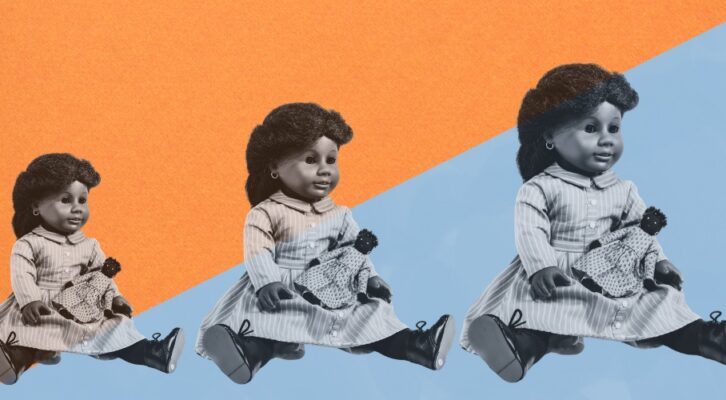
Meet Addy: The Story of the First Black American Girl Doll
Jaha Nailah Avery on the Significance of Addy Walker
On the day I was born, a member of our church brought a big, beautiful stuffed doll to the hospital as a gift to celebrate my arrival. The doll has thick black hair, styled in two plaits on either side of her head. Her dark brown skin and big black eyes are complemented by an ornate white and purple floral outfit, trimmed in lace. She’s lovely, and even today, she garners attention from everyone who visits my home. She was my first doll, and marked the start of my lifelong hobby of doll collecting.
I was a young child in 1993 when American Girl released its first Black doll, Addy Walker. Though I had heard of American Girl dolls, they weren’t on my radar, nor that of my friends, until we saw a girl who looked like us. When Addy hit the scene, we entered the American Girl craze full force, begging our parents and grandparents for the books, dolls, furniture, and add-ons. I still have my original Addy books and my original Addy doll, which now sits beside the doll I received as a newborn. The two of them together are the most meaningful dolls in my, now vast, collection.
It’s no surprise that I was immediately drawn to Addy and her story all those years ago, but a recent discovery for me was surprising: Addy was a Carolina girl, like me.
*
I stepped out of my car onto the Stagville Plantation in Durham, North Carolina on a bright, sunny April day. Just days prior, I’d had a long, rich conversation with Connie Porter, author of the American Girl, Addy series. She informed me that when she initially became attached to the project, the young girl she was supposed to be writing about already had a name: Addy Walker. Porter was given much creative liberty in the making of Addy, including her family structure, her plotline across the course of the series, how she would escape to freedom, and pretty much everything else. But her name was non-negotiable.
Every historical American Girl doll was accompanied by a series of books about her life. In the first book of Addy’s series, we meet her as a nine-year-old child, highly intelligent and full of hope, but enslaved with her family on a plantation. When I first read the series, I was just a few years younger than Addy. I recognized the injustice and brutality present in her world, but what stood out most to me was Addy’s own bravery and resilience. In re-reading the series a few weeks ago, though, it was just the opposite; while I had the same respect and awe for Addy’s brilliance and courage, I was gutted while reading about the casual barbarism that was a reality for generations of enslaved African Americans.
We accepted Addy in ways many adults could not, because we understood that slavery was her circumstance, not her story. Being enslaved is what she was, but it wasn’t who she was.
I suppose it makes sense that adult me is triggered by the “strange white man” touching Addy’s head like she’s an animal, now that I’ve experienced white people attempting to do the same to me when my natural hair is flowing freely. It stands to reason that my heart now aches deeply at Momma having to make the necessary choice to leave her young child behind in slavery, in order to successfully run to freedom, now that I’ve had to utter impossible goodbyes myself amid the backdrop of crushing loss.
Addy’s parents have a conversation with her about the need to hide her feelings, explaining to her that “We ain’t always free to show our feelings on the outside. But on the inside, we free. There’s always freedom inside your head, Addy.” This is not dissimilar to conversations that my own parents and grandparents had to have with me and my siblings in our younger years, showing us how to code switch in situations where not doing so could lead to dire consequences. For Addy, not code switching could have meant being whipped, or sold away from her family. For me, not code switching could have meant expulsion from law school, or later, job loss. Addy’s parents are my parents. Many of the truths they shared with her remain America’s truths today.
Walking up to the visitor center to buy my ticket, I could see the “Big House” up on the hill to my right, and I saw small wooden cabins dotting the land behind it. On the tour, I was about to learn about an enslaved woman named Mary Walker, separated from where I presently stood by several miles and 200 years. She had a young daughter named Agnes, whom everyone called “Aggy.” Mary Walker became one of few people to escape from Stagville, settling down in Philadelphia, and later, Boston. But, with her freedom also came her heartache. She left her daughter Aggy Walker behind, along with her two other children. Fictional Addy saw freedom long before real-life Aggy did, but after the Civil War, Aggy, newly freed, managed to reunite with her mother.
Stagville Plantation once spread out across 47 miles, making it one of the largest plantations in the South at the time. As our tour group crosses the vast grounds of the plantation, cabins that made up part of “Slave Row” loom ahead of us, and Porter’s words ring in my ear. “Addy is not ‘a slave,’ she’s a child. She believes in the good of people, and she believes in the ideals of what this country is supposed to stand for. She was enslaved, but there was still hope in her world, there was still joy in her world. That is the story. But, in America, freedom’s got a cost.”
We come to the foundation of what once held a small cabin where enslaved people who worked in the Big House lived. Our guide pulls out a cowrie shell, a gleaming charm sitting in the middle of her hand. The cowrie’s elegance and delicacy may deceive the casual onlooker, initially disguising what I know it also possesses: Extraordinary strength and resolve.
I first learned about cowrie shells from my Addy books; the morning after Momma and Addy run away from the plantation, they hide in a cave to rest. Momma gives Addy a cowrie shell, telling her it had belonged to Addy’s great-grandmother, her namesake, Aduke (meaning “much loved”). Aduke had been stolen from West Africa as a young girl, and had brought the cowrie shell with her across the Atlantic. Momma gives it to Addy to honor her bravery, the same valor that her great-grandmother had possessed in surviving Middle Passage, the auction block, and life on the plantation. “There’s one thing different about you and your great-grandma,” Momma tells Addy. “Her journey ended in slavery. Yours, girl, is taking you to freedom.”
The cowrie shell that was found in the small cabin at Stagville was also brought from West Africa. Like the one Aduke brought, it was guarded and cherished by someone who was enslaved on the plantation, perhaps bringing dreams of home, family, and legacy to its protector. In the 1980s, North Carolina historian Alice Jones began interviewing descendants of people enslaved at Stagville and preserving their stories. She was the first African American historian to conduct research at Stagville, first serving as a Stagville Fellow, and later, researching for her graduate thesis at North Carolina Central University, “Afro-American Cultural Traditions at Stagville and Fairntosh Plantations.” The richness and depth of her work is a testament to why it’s important to have African American stories facilitated and preserved by African American people.
Jones’s work was later discovered by someone at Pleasant Company, and in 1991, her research laid the foundation for the story of Addy Walker. While researching for this article, I came across a photo of Jones at Stagville, in conversation with Rosa Parks. They are standing over Jones’s desk, both smiling. The photo was taken in 1996, by which time Addy Walker had been the subject of both admiration and criticism, and Jones’s research had gained prominence outside North Carolina, due to Addy’s popularity. Parks was visiting Stagville to attend one of Jones’s lectures about her research, and its connection to Addy.
So, Jones laid the foundation, and Porter built the house. “I think Addy has survived this long because it speaks to the idea that the joy we as African Americans have, the world didn’t give, and the world can’t take away,” Porter opines. “With Addy, I had to let the nine-year-old shine through. We see that in the moments where Addy’s mother is combing her hair, moments when Addy is doing something as simple as having a snack. I think the details of Addy’s life still resonate with little girls…friendship and dreams, those moments of happiness. And, also sometimes, those moments of loss.”
Decades later, Addy remains a cultural icon, emblazoned on the hearts of all the young Black girls who read about her in their books, dressed her in doll form, and saw themselves in her, from her curiosity and bright smile, to her textured hair and exquisite cowrie shell necklace. When Addy was released in 1993, and adults were debating about why the first Black American Girl doll had to be enslaved, my friends and I relished in the belief that, like Addy, we were courageous, we were thoughtful, and we were resourceful. We accepted Addy in ways many adults could not, because we understood that slavery was her circumstance, not her story. Being enslaved is what she was, but it wasn’t who she was. She was an American girl, she was a Carolina girl, she was us, and we were her: Young, Black, and (eventually, for Addy) free.
Jaha Nailah Avery
Jaha Nailah Avery is an African American woman and proud Southerner. Hailing from Asheville, North Carolina, she received her law degree from The University of North Carolina at Chapel Hill, where she studied constitutional law. She spent time in the startup tech space before embarking on her professional writing career, and her work can be found in ESSENCE, The New York Times, Rolling Stone, Vanity Fair and Architectural Digest. She's a member of Delta Sigma Theta Sorority, Inc., a harpist, and an avid traveler. Her aim is to always celebrate and preserve the stories of Black people, culture, and history.



















